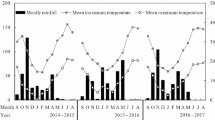Abstract
This paper reports on the use of three leguminous perennials (Leucaena leucocephala, Flemingia macrophylla and Gliricidia sepium) as live support systems in yam cultivation. In a planting arrangement in which yam rows alternated with rows of the woody species the tuber yields per ha were 3.4 (leucaena), 5.3 (flemingia) and 10.1 (gliricidia) ton fresh weight. TUKEY's L.S.D. value equalled 2.9 ton.
Leucaena leucocephala is unsuitable as live support since the species shows a strong competitive power expressed in terms of leaf productivity and relative density of the root mass in the upper soil stratum, the zone explored by the yam crop.
Flemingia macrophylla is unsuitable as support species mainly because of its structural weakness: Its branches do not sufficiently lignify to carry the yam leaf mass.
The significantly higher tuber yield of the yam crop grown with Gliricidia sepium is a function of specific properties of the tree species: Low leaf productivity, a relatively weakly developed root system and an open architecture, which leaves sufficient space for a yam crop grown in association.
Similar content being viewed by others
References
Agboola AA, Wilson GF, Getahun A and Yamoah CF (1982) Gliricidia sepium: A possible means to sustained cropping in Western Nigeria. In: MacDonald LH (Ed); Agroforestry in the African humid tropics. Tokyo, Japan. p 141–143
Aken'ova ME and Atta-Krah AN (1986) Control of Speargrass in an Alley-cropping fallow. NFTA Research Reports 4: 27–28
Budelman A (1988) The performance of the leaf mulches of Leucaena leucocephala, Flemingia macrophylla and Gliricidia sepium in weed control. Agroforestry Systems 6: 137–145
Budelman A (1988) Leaf dry matter productivity of three selected perennial leguminous species in humid tropical Ivory Coast. Agroforestry Systems 7: 47–62
Budelman A (1988) The decomposition of the leaf mulches of Leucaena leucocephala, Gliricidia sepium and Flemingia macrophylla under humid tropical conditions. Agroforestry Systems 7: 33–45
Budelman A (1989) Nutrient composition of the leaf biomass of three selected woody leguminous species. Agroforestry Systems 8: 39–51
Budelman A (1989) The performance of selected leaf mulches in temperature reduction and moisture conservation in the upper soil stratum. Agroforestry Systems 8: 53–66
Budowski G, Kass DCL and Russo RO (1984) Leguminous trees for shade. Pesquisa Agropecuaria Brasileira 19 s/n: 205–222
Clayton WD (1958) Secondary vegetation and the transition to savanna near Ibadan, Nigeria. Journal of Ecology 46 (2): 217–238
Ewel J, Benedict F, Berish C, Brown B, Gliessmann S, Amador M, Bermudez R, Martinez A, Miranda R and Price N (1982) Leaf area, light transmission, roots and leaf damage in nine tropical plant communities. Agro-ecosystems 7: 305–326
Huxley PA (1985) The tree-crop interface or simplifying the biological environmental study of mixed cropping agroforestry systems. Agroforestry Systems 3: 252–266
Jonsson K, Fidjeland L, Maghembe JA and Hogberg P (1988) The vertical distribution of fine roots of five tree species and maize in Morogoro, Tanzania. Agroforestry Systems 6: 63–69
Kang BT, Wilson GF and Lawson TL (1984) Alley-cropping; A stable alternative to shifting cultivation. International Institute of Tropical Agriculture, Ibadan. Nigeria, 23 pp
Onwueme IC (1978) The tropical tuber crops. Yams, Cassava, Sweet potato, and Cocoyams. John Wiley & Sons. Chichester. Section A. pp. 1–106
Onwueme (1981) Strategies for progress in yam research in Africa. In: Terry ER, Oduro KA and Caveness F (Ed) Tropical Root Crops Research Strategies for the 1980's. Proceedings 1st Triennial Root Crops Symposium of the International Society for Tropical Root Crops- Africa branch, 8–12 september 1980. Ibadan, Nigeria. p. 173–176
Wilson GF and Akapa K (1981) Improving the in-situ stem support system for yams. In: Terry ER, Oduro KA and Caveness F (Ed) Tropical Root Crops Research Strategies for the 1980's. Proceedings 1st Triennial Root Crops Symposium of the International Society for Tropical Root Crops- Africa branch, 8–12 september 1980. Ibadan, Nigeria. p 195–197
Author information
Authors and Affiliations
Rights and permissions
About this article
Cite this article
Budelman, A. Woody legumes as live support systems in yam cultivation. Agroforest Syst 10, 47–59 (1990). https://doi.org/10.1007/BF00118726
Issue Date:
DOI: https://doi.org/10.1007/BF00118726




